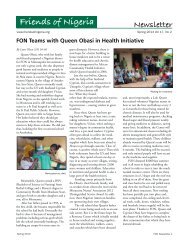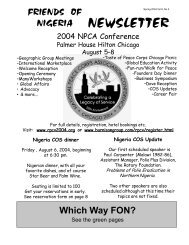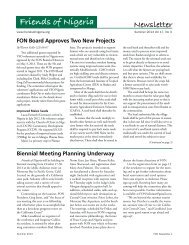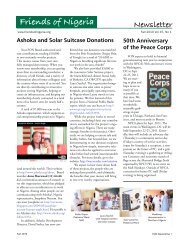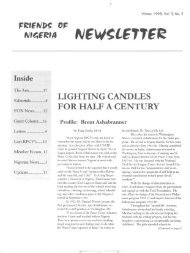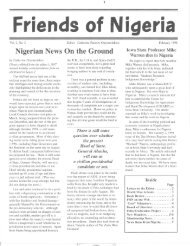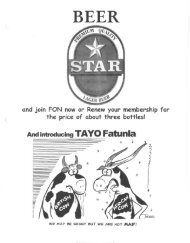0704 Summer 2003.pdf - Friends of Nigeria
0704 Summer 2003.pdf - Friends of Nigeria
0704 Summer 2003.pdf - Friends of Nigeria
You also want an ePaper? Increase the reach of your titles
YUMPU automatically turns print PDFs into web optimized ePapers that Google loves.
Book ReviewMesa Verde Press, Indianapolis IN. ISBN 0-9607220-2-5, tradepaper, 144pp., $14.95, 2002. Illus: Photos shot by author during war;maps <strong>of</strong> Africa, <strong>Nigeria</strong>, and Biafra; chronology <strong>of</strong> events; glossary.How difficult it is to be objective about a book that bringstears to the eyes! As our 2002America talks <strong>of</strong> war, I read,almost in relief, the “war stories”<strong>of</strong> John Sherman, a Peace Corpsvolunteer in <strong>Nigeria</strong>/Biafra in themid-1960s. At least those sick,frightened and dying children mayhave survived the immediate pain<strong>of</strong> war by now or more likely, theyhave died and their suffering isover. Nevertheless, as I stand inJohn when workingin Malawi in 1968.line at a local grocery for myannual flu shot dispensed by acareless man who keeps droppingparts <strong>of</strong> the syringes on the floor, I think <strong>of</strong> Biafra.After graduating from college, John Sherman joined thePeace Corps and was sent to <strong>Nigeria</strong> to teach English at asecondary school in that country’s Eastern Region in 1966. Lessthan a year later, that area seceded from <strong>Nigeria</strong> and declareditself to be the Republic <strong>of</strong> Biafra. As relations between the twogovernments worsened into a civil war, the Peace Corpsevacuated its volunteers and sent Sherman to Malawi. Hereturned to <strong>Nigeria</strong> in August <strong>of</strong> 1968 with un<strong>of</strong>ficialdocuments, hoping in some way to alleviate the suffering <strong>of</strong> theBiafran refugees and make contact with his former students.Feeling he was a loose ball bouncing around Africa, he was ableto work with the International Committee <strong>of</strong> the Red Cross(ICRC) near where he had been teaching in Biafra before it wasreclaimed by the <strong>Nigeria</strong>n military.Using a journal from that time, Sherman has composed abittersweet memoir <strong>of</strong> events and feelings he experienced in thatthree-year period. With the aid <strong>of</strong> aliterary device he moves back and forthbetween his return as an ICRC workerand the Peace Corps period which, inthe book, is indicated by italics. Heremembers fondly many funny, happytimes with his students, their families andthe general state <strong>of</strong> being white in ablack society. These italicized paragraphsreveal a joy <strong>of</strong> living, dancing the HighLife (a popular, energetic dance), sharinggroundnuts (peanuts), learning to snapLt. Col. ChukuemekaOdumegwu Ojukwuin 1967.10 12 FON NEWSLETTERReviewed by Betty ParkerWar Stories:A Memoir <strong>of</strong> <strong>Nigeria</strong> and Biafraby John Sherman (23) 66–67fingers in a handshake (I still can’t do it)and a feeling he was making acontribution.The book begins as Sherman is attempting to get back toBiafra. These paragraphs, which describe the Red Cross portion<strong>of</strong> his African journey, though factual, are also vehicles <strong>of</strong> a sadwisdom, revealing a young man determined to make a differencein a situation in which he has little control and great personalrisk. Once, when he witnesses almost more suffering than he cantake, he wishes that just for a few hours, he could be somewherewhere his values are not tested. When soldiers who terrorize hisfriends need food or medicine, he questions whether or not ahuman is still human in a uniform. Because he is in an areawhere he is dispensing food and medicine to both <strong>Nigeria</strong>n andBiafran refugees, he muses about being forced to be neutral.He speaks <strong>of</strong> war as the “last great horror we inflict uponourselves,” and because he is touched more by the children whocan no longer smile, he reminds us that books can be reprintedbut children cannot be replaced. As an antiquarian bookseller Ihave to agree grudgingly that he is right, at least in spirit.Sherman left Africa in 1969, but returned in 1971 to work inGhana in both the Peace Corps <strong>of</strong>fice and as national director<strong>of</strong> the American Field Service. He took courses in AfricanStudies at the University <strong>of</strong> Ghana, and he also taught in Zairebefore returning to the United States in 1975.He and his family lived in Santa Fe, New Mexico from 1977-85. While there he edited El Palacio magazine, worked at St.Catherine Indian School and wrote a “Generally Sherman”humor column for the Santa Fe Reporter. He also did a series <strong>of</strong>features for the Albuquerque Journal North on historic Santa Fe.“Santa Fe, A Pictorial History” was first published for the FirstNational Bank there in 1983 and is now a scarce piece <strong>of</strong> SantaFe literature in the original limited edition. It was reprinted in1996, and “Taos, A Pictorial History” was published in 1990.•Reviewed for and originally published in SouthwestBookViews, Winter 03, Vol. 2, Issue 1. Reprinted withpermission. A generalist in her love <strong>of</strong> books, Betty Parkerreviews a wide range <strong>of</strong> material for Southwest BookViews.John Sherman has lived and worked in <strong>Nigeria</strong> (twice), Biafra,Malawi, Ghana and Zaire. He is currently a resident <strong>of</strong>Indianapolis. He and his wife Lois, who was also in <strong>Nigeria</strong>(23) anda teacher at Sir Francis Ibiam Secondary School in Afikpo, and wasevacucated to Togo, have two children,Chizoma and David. John has had acareer which included being a classroomteacher <strong>of</strong> English and Journalism tana marketing and PR executive in thenonpr<strong>of</strong>it and corporate world. Hecurrently owns a PR firm inIndianapolis and pursues an activefreelance writing career. He is theauthor <strong>of</strong> three books <strong>of</strong> poetry andtwo pictorial history books.John in 2002.



